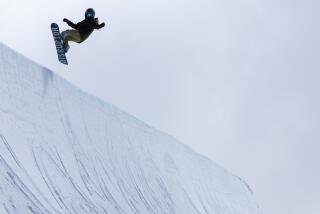Hitting the Trail
Mountain bikers are increasingly doing just that--hitting the trail literally. Accidents are causing a growing number of injuries, many of them well beyond the scrapes-and-scratches variety. With mountain bike season shifting into high gear, here’s a guide to safe riding:
BIKING BRUISES
There were 36,820 mountain bike injuries recorded in the U.S. in 1995, a 57% increase from the previous year. A closer look at 1995’s injuries:
Head: 20%
Shoulder: 16%
Elbow: 6%
Lower arm/hand: 19%
Upper trunk: 7%
Lower trunk: 4%
Legs/feet: 14%
25-50% of body: 11%
All parts: 1%
Other: 2%
INJURY TYPE
Contusion: 32%
Laceration: 23%
Fracture: 17%
Strain/sprain: 14%
Dislocation: 3%
Concussion: 2%
Other: 9%
MOUNTAIN WISDOM
To avoid injuries, keep these recommendations in mind:
* Bike should fit your body; ask store for help in adjusting seat and handlebars to fit you
* Wear properly fitting bicycle helmet
* Use eye protection
* Be alert to changing terrain and potential hazards such as potholes, branches or rocks
* Do not cycle too closely behind another mountain biker
* Use both brakes equally; applying one or both suddenly can cause an “endo” (end over handlebars)
* Do not ride too fast; keep speed under control
* Ride with a partner at the same skill level
* Be ready to brake at all times
* To prevent erosion, avoid skidding, reduce speed in corners and don’t cut switchbacks or bushwhack off trails
* Bend at waist toward bike whenever possible
* Keep elbows close to body rather than stuck out; this helps steering
* When riding on gravel, use your body weight to move your bike rather than the handlebar and front wheel
OFF-ROAD ETIQUETTE
* Be courteous to other trail users.. Give advance warning when approaching hikers, horseback riders and other bikers.
HOW TO RIDE
PEDALING UPHILL
Keep body down down close to the bike, bent at waist, butt back, pulling on handlebars toward hips, not chest. Staying seated adds weight over rear wheel and increases traction. Staying seated can be alternated with standing, which uses upper-body strength to pulse rear tire by pulling back and up on handlebar at start of each pedal stroke.
CRUISING DOWNHILL
Keep butt back, out of saddle, with thighs resting against rear part of saddle, waist and arms bent. Keep feet horizontal on pedals Staying out of seat helps absorb shocks, bumps and ruts.
JUMPING OBSTACLES
Mountain bikes are generally built to take the abuse of riding over logs, rocks and other obstacles. Clearing obstacles takes a well-built bike, and skill on the part of the rider. The technique for riding over any obstacle involves three components:
1. Ride fast enough to get up onto obstacle.
2. Have enough momentum to get over obstacle..
3. Keep weight evenly distributed for descent, sifting center of gravity to rear of bike.
TURNING
Keep inside leg up and outside leg down, bending body into bike and lowering center of gravity. Lean rather than steer into turn to increase contact of tires with ground. Begin braking before rather than during turn.
TREADS FOR A REASON
Mountain bike tires are knobby for high traction when gripping rough terrain. Treads vary according to riding surface. In general, wider, deeper treads are used for unpaved surfaces. Flatter treads are an option for faster rides with minimal rolling resistance. Serious bikers match tires to riding surface.
A. For hard surfaces
B. For loose dirt
C. For climbing and cornering
D. For smooth surfaces
*
Sources: CORBA; Mountain Bike magazine: “Bicycling Magazine’s Mountain Biking Skills”; “Bicycling: Touring and Mountain Bike Basics” by Peter Oliver; “Mountain Bike Magic” by Rob Van der Plas; “The Basic Essentials of Mountain Biking” by Mike Strassman; REI; Consumer Product Safety Commission; American Academy of Orthopaedic Surgeons; Researched by JULIE SHEER and PETER NOAH / Los Angeles Times
More to Read
Sign up for The Wild
We’ll help you find the best places to hike, bike and run, as well as the perfect silent spots for meditation and yoga.
You may occasionally receive promotional content from the Los Angeles Times.






